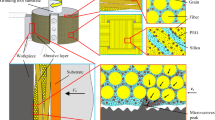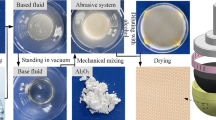Abstract
Inconel718 alloy is widely employed in aerospace industries due to its excellent thermo-mechanical property. As a typical difficult-to-machine material, it is extremely easy to cause grinding burns, surface scratches, and grinding wheel blockages during traditional grinding. In this work, we developed a super elastic composite abrasive tool (ECAT) based on the principle of liquid body armor and proposed a high-shear and low-pressure precision intelligent grinding method. The grinding experiments of selective laser melting (SLM)–fabricated Inconel718 workpiece was conducted to explore the grinding characteristics of ECAT using the precision intelligent grinding system. The optimal grinding parameters were explored. Under the optimal grinding parameters, the surface roughness of the SLM workpiece was reduced from 385.2 to 44.5 nm after 40 grinding strokes. The material removal rate was about 0.42 μm/min. The surface quality of the workpiece was significantly improved. In addition, the grinding force with different abrasive layers was investigated. It was found that the average ratio of the tangential force (Ft) to the normal force (Fn) of an abrasive layer with liquid-body-armor-like abrasive system is 0.427, which was much higher than that of 0.162 for pure high-performance fabrics (without liquid-body-armor-like abrasive system). The high-shear and low-pressure grinding characteristic of ECAT was verified.













Similar content being viewed by others

References
Bartolomeis AD, Newman ST, Jawahir IS, Biermann D, Shokrani A (2021) Future research directions in the machining of Inconel718. J Mater Process Tech 297:117260. https://doi.org/10.1016/j.jmatprotec.2021.117260
Li YH, Zhang Z, Guan YC (2020) Thermodynamics analysis and rapid solidification of laser polished Inconel718 by selective laser melting. Appl Surf Sci 511:145423.1–145423.7. https://doi.org/10.1016/j.apsusc.2020.145423
Chen ZZ, Xu JH, Ding WF, Ma CY (2014) Grinding performance evaluation of porous composite-bonded CBN wheels for Inconel 718. Chin J Aeronautics 27(4):1022–1029. https://doi.org/10.1016/j.cja.2014.03.015
Zhang BC, Li XH, Bai JM, Guo JF, Wang P, Sun CN, Nai ML, Qi GJ, Wei J (2017) Study of selective laser melting (SLM) Inconel718 part surface improvement by electrochemical polishing. Mater Des 116:531–537. https://doi.org/10.1016/j.matdes.2016.11.103
Periane S, Duchosal A, Vaudreuil S, Chibane H, Morandeau A, Cormier J, Leroy R (2019) Machining influence on the fatigue resistance of Inconel718 fabricated by Selective Laser Melting (SLM). Procedia Structural Integr 19:415–422. https://doi.org/10.1016/j.prostr.2019.12.045
Naik DN, Mathew NT, Vijayaraghavan L (2019) Wear of electroplated super abrasive CBN wheel during grinding of Inconel718 super alloy. J Manuf Process 43:1–8. https://doi.org/10.1016/j.jmapro.2019.04.033
Zhang YB, Li CH, Ji HJ, Yang XH, Yang M, Jia DZ, Zhang XP, Li RZ, Wang J (2017) Analysis of grinding mechanics and improved predictive force model based on material-removal and plastic-stacking mechanisms. Int J Mach Tool Manu 122:81–97. https://doi.org/10.1016/j.ijmachtools.2017.06.002
Sun JL, Qin F, Chen P, An T (2016) A predictive model of grinding force in silicon wafer self-rotating grinding. Int J Mach Tool Manu 09:74–86. https://doi.org/10.1016/j.ijmachtools.2016.07.009
Wu Y, Shen MB, Qu MN, Xie GZ, Shang ZT, Jin T (2019) An experimental investigation on surface layer damage in high-efficiency and low-damage grinding of rail by slotted CBN grinding wheel. Int J Adv Manuf Tech 105(7–8):2833–2841. https://doi.org/10.1007/s00170-019-04528-x
Peng RT, Zhao LF, Tong JW, Chen ML, Zhou MZ, Li A (2022) Design and evaluation of an internal-cooling grooved grinding wheel. J Manuf Process 73:1–16. https://doi.org/10.1016/j.jmapro.2021.10.061
Peng RT, Tong JW, Zhao LF, Tang XZ, Peng X, He XB (2020) Molecular dynamics study on the adsorption synergy of MWCNTs/MoS2 nanofluids and its influence of internal-cooling grinding surface integrity. Appl Surf Sci 563:150312. https://doi.org/10.1016/j.apsusc.2021.150312
Dai CW, Ding WF, Zhu YJ, Xu JH, Yu HW (2017) Grinding temperature and power consumption in high speed grinding of Inconel718 nickel-based superalloy with a vitrified CBN wheels. Precis Eng. https://doi.org/10.1016/j.precisioneng.2017.12.005
Ding WF, Liu ZW, He J, Zhao HY, Wang Y, Liang YM (2012) Grinding performance of titanium alloy Ti-6Al-4V with monolayer brazed CBN slotted wheels. Key Eng Mater 522:162–166. https://doi.org/10.4028/www.scientific.net/KEM.522.162
Bingham RG, Walker DD, Kim D-H, Brooks D, Freeman R, Riley D (2000) A novel automated process for aspheric surfaces. Int Soc Optical Eng 4093:445–450. https://doi.org/10.1117/12.405237
Song JF, Yao YX (2015) Material removal model considering influence of curvature radius in bonnet polishing convex surface. Chin J Mechanical Eng 28(6):1109–1116
Beaucamp A, Namba Y, Combrinck H, Charlton P, Freeman R (2014) Shape adaptive grinding of CVD silicon carbide. CIRP Annals - Manuf Tech 63(1):317–320. https://doi.org/10.1016/j.cirp.2014.03.019
Zeng X, Qiu WB, Ji SM, Xi FF, Qiu L, Zheng QQ, Shi M (2019) Optimization and experimental research on process parameters of the softness consolidation abrasive particles. Int J Adv Manuf Tech 104 (1–4). https://doi.org/10.1007/s00170-019-03467-x
Tian YB, Li LG, Fan S, Guo QJ, Cheng X (2021) A novel high-shear and low-pressure grinding method using specially developed abrasive tools. Proc Inst Mechanical Engineers Part B J Eng Manu 235 (1–2):166–72. https://doi.org/10.1177/0954405420949106
Tian YB, Li LG, Liu B, Han JG, Fan ZH (2020) Experimental investigation on high-shear and low-pressure grinding process for Inconel718 superalloy. Int J Adv Manuf Tech 107(7–8):3425–3435. https://doi.org/10.1007/s00170-020-05284-z
Tian YB, Li LG, Liu B, Han JG, Fan ZH, Liu K (2020) Development of novel high-shear and low-pressure grinding tool with flexible composite. Mater Manuf Processes 36(4):1–9. https://doi.org/10.1080/10426914.2020.1843673
Li M, Lyu BH, Yuan JL, Dong CC, Dai WT (2015) Shear-thickening polishing method. Int J Mach Tool Manu 94:88–99. https://doi.org/10.1016/j.ijmachtools.2015.04.010
Funding
This work was financially supported by the National Natural Science Foundation of China (Nos. 51875329 and 51,905,322), the China postdoctoral Science Foundation (No. 2021T140420), the Taishan Scholar Special Foundation of Shandong Province (No. tsqn201812064), the Shandong Provincial Natural Science Foundation (No. ZR2017MEE050), the Shandong Provincial Key Research and Development Project (No. 2018GGX103008), the Scientific Innovation Project for Young Scientists in Shandong Provincial Universities (No. 2019KJB030), and the Key Research and Development Project of Zibo City (No. 2019ZBXC070).
Author information
Authors and Affiliations
Corresponding author
Ethics declarations
Ethics approval
This article does not contain any studies with human participants or animals performed by any of the authors.
Consent to participate
Not applicable.
Consent for publication
All authors have read and agreed to the published version of the manuscript.
Competing interests
The authors declare no competing interests.
Additional information
Publisher's Note
Springer Nature remains neutral with regard to jurisdictional claims in published maps and institutional affiliations.
Rights and permissions
Springer Nature or its licensor holds exclusive rights to this article under a publishing agreement with the author(s) or other rightsholder(s); author self-archiving of the accepted manuscript version of this article is solely governed by the terms of such publishing agreement and applicable law.
About this article
Cite this article
Gu, Z., Tian, Y., Han, J. et al. Characteristics of high-shear and low-pressure grinding for Inconel718 alloy with a novel super elastic composite abrasive tool. Int J Adv Manuf Technol 123, 345–355 (2022). https://doi.org/10.1007/s00170-022-10179-2
Received:
Accepted:
Published:
Issue Date:
DOI: https://doi.org/10.1007/s00170-022-10179-2



